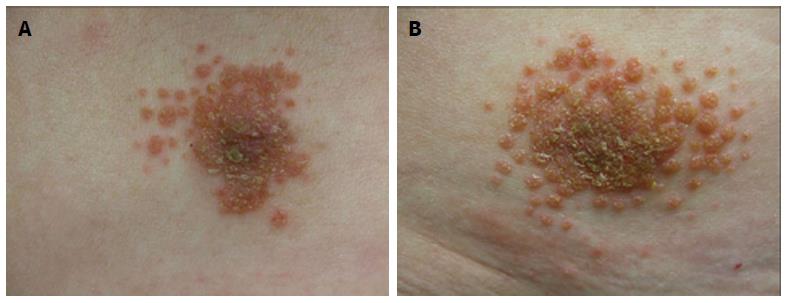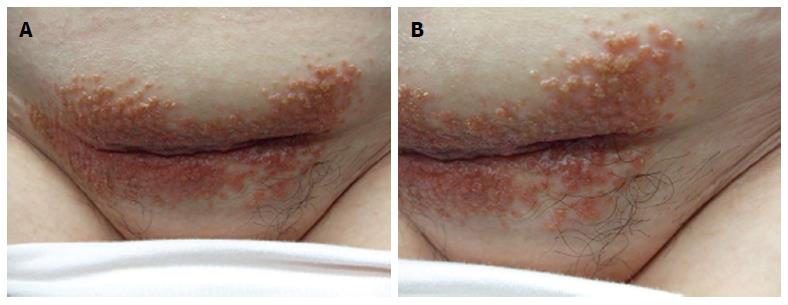Copyright
©2014 Baishideng Publishing Group Inc.
World J Clin Cases. Dec 16, 2014; 2(12): 815-821
Published online Dec 16, 2014. doi: 10.12998/wjcc.v2.i12.815
Published online Dec 16, 2014. doi: 10.12998/wjcc.v2.i12.815
Figure 1 Neomycin-associated follicular contact dermatitis presenting as follicular papules on the right abdomen, in and around the umbilicus, and the suprapubic region.
The patient is a 59-year-old Asian woman who presented with itchy lesions at the sites of prior incisions on her lower abdomen. Her past medical history was significant for stage I, T2N0M0 adenocarcinoma of the sigmoid colon. Her tumor was successfully managed by a laparoscopic anterior resection of the sigmoid colon.
Figure 2 Closer view of neomycin-associated follicular contact dermatitis on the right mid abdomen (A) and right lower abdomen (B).
The woman noted, one month postoperatively, that there was still some drainage from her surgical wounds. She was instructed to daily clean the sites and apply an antibiotic ointment that contained neomycin sulfate, polymyxin B zinc, and bacitracin zinc (Neosporin ointment). She began to develop small individual lesions at the sites of antibiotic ointment application after 6 wk of daily topical treatment; however, she continued to treat the incision sites for another 4 wk as the individual lesions enlarged and some become confluent-before seeking medical attention.
Figure 3 Cutaneous examination of her abdomen and suprapubic region (A) showed individual and confluent red-brown pruritic papules where she had been applying the antibiotic ointment to prior incision sites: right mid abdomen, right lower abdomen, umbilicus and periumbilical area (B, distant view and C, closer view) and suprapubic region.
Figure 4 Distant (A) and closer (B) inspection, particularly of the lesion in her suprapubic area, showed individual hair follicles in the center of the papules.
The topical antibiotic was discontinued and flucinonide 0.05% cream was applied twice daily; all of the lesions resolved within 2 wk with residual post inflammatory hyperpigmentation at the sites.
- Citation: Cohen PR. Follicular contact dermatitis revisited: A review emphasizing neomycin-associated follicular contact dermatitis. World J Clin Cases 2014; 2(12): 815-821
- URL: https://www.wjgnet.com/2307-8960/full/v2/i12/815.htm
- DOI: https://dx.doi.org/10.12998/wjcc.v2.i12.815












